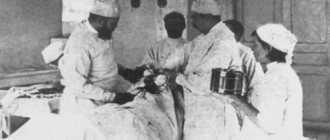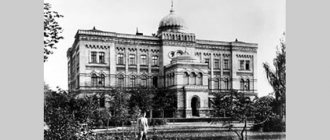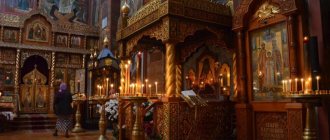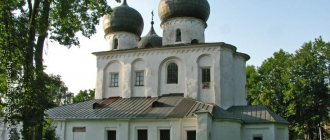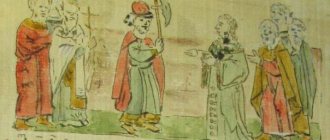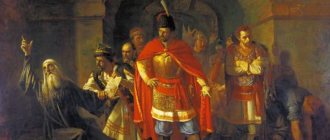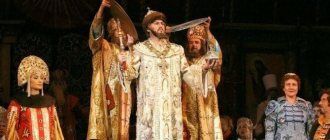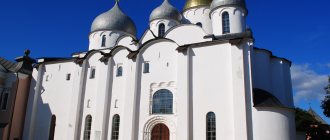| Novgorod diocese | |
| Novgorod St. Sophia Cathedral is the oldest Orthodox church in Russia | |
| A country | Russia |
| Church | Russian Orthodox Church |
| Metropolis | Novgorod Metropolis |
| Date of foundation | end of 10th century |
| Control | |
| Main city | Velikiy Novgorod |
| Cathedral | Novgorod St. Sophia Cathedral |
| Hierarch | Metropolitan of Novgorod and Old Russian Lev (Tserpitsky) (since July 20, 1990) |
| Suffragan bishops | Arseny (Perevalov), Bishop of Yuryevsky |
| Statistics | |
| Deanery | 5 |
| Temples | 93 [1] |
| vn-eparhia.ru | |
| Media files on Wikimedia Commons | |
The Novgorod diocese
is a diocese of the Russian Orthodox Church on the territory of the Novgorod, Starorussky, Batetsky, Valdai, Volotovsky, Demyansky, Krestetsky, Malovishersky, Marevsky, Parfinsky, Poddorsky, Soletsky, Kholmsky, Chudovsky and Shimsky districts of the Novgorod region [2]. Along with Kyiv, it is the oldest institution in Rus'.
In various periods it included very vast and varied territories (in the synodal and Soviet periods it was often united with the St. Petersburg diocese): St. Petersburg, Olonets province, Estland, Vyborg, the Grand Duchy of Finland, Pomerania.
The title of the ruling bishop changed many times; the diocese itself was called “Novgorod” until the end of the 20th century; Since the 1990s, the name has been adopted after the modern title of the ruling bishop.
Story
Middle Ages
Established at the end of the 10th century; sources vary on the exact date. The first bishop in Novgorod is considered to be Joachim, who may have arrived from Korsun along with Prince Vladimir.
Before the annexation of the Novgorod Republic to the Moscow Principality in 1478, ruling bishops were elected by lot, after which they usually received appointments from the Kyiv metropolitans. Sometimes the veche took part in the election procedure; It is believed that the first bishop elected in 1156 was Arkady, and the first deposed in 1228 was Archbishop Arseny.
In 1155, Yuri Dolgoruky removed from the Kyiv metropolitanate illegally (without the blessing of the Patriarch) Kliment Smolyatich, who had been appointed by the will of the Kyiv prince Izyaslav Mstislavich. At the end of 1156, the new Metropolitan Constantine I was received from Constantinople. For loyalty in supporting his policies by the Novgorod bishop Niphon during the unrest, the Patriarch of Constantinople granted the Novgorod diocese some autonomy from the Kyiv metropolitan.
Since 1165, under John I, the Novgorod see became the first archbishopric in Russia. In Byzantium, the title of archbishop usually belonged to “autocephalous” bishops, that is, those who were subordinate not to the metropolitan, but directly to the Patriarch.
In the 12th-13th centuries, Yuriev Monastery became the state monastery of the Novgorod Republic, and its head, the Novgorod archimandrite, became the head of the city magistrates.
In 1346, Archbishop Basil Kalika was granted the right to wear the polystavrion (“baptized robe,” that is, a phelonion decorated with four crosses), a privilege enjoyed only by the highest-ranking Byzantine hierarchs.
The ruling bishops until 1589 bore the title “Archbishop of Velikonovgorod and Pskov”; the first archbishop was St. John (Elijah).
In the 1470s, Novgorod became a hotbed of the spread of the Judaizer heresy in North-Eastern Rus'.
At the end of the 15th century, at the court of Novgorod Archbishop Gennady, the first complete corpus of the Slavic Bible was compiled, known as the Gennadian Bible (1499).
From the end of the 14th century, beginning with Archbishop John, the primates of the diocese were in frequent conflict with the expansionist claims of the Moscow princes.
After the first successful campaign against Novgorod in 1471, Ivan III forced the Novgorodians to “ install an archbishop in Moscow.”
"[3]. The last bishop elected by lot was St. Theophilus († October 26, 1484): elected in December 1471 and consecrated in Moscow on December 15, 1472. However, Theophilus was already removed from the pulpit on January 19, 1480 by order of the Grand Duke and imprisoned in the Chudov Monastery. In the last quarter of the 15th century, a significant part of the estates of the Novgorod ruler and monasteries was confiscated[4].
The next serious conflict between the Novgorod ruler and the power of the Moscow prince was the excommunication from the Church in April 1509 by Saint Serapion of the abbot and founder of the Volotsk monastery, St. Joseph - the monastery was then under the jurisdiction of the Novgorod see. The excommunication was imposed for the latter’s arbitrariness, which consisted, in the opinion of the Novgorod archbishop, in the abbot’s complaint directly to the Moscow Metropolitan Simon and Vasily Ivanovich in 1507 against his appanage prince Theodore Borisovich (the Grand Duke’s cousin). At the Council of 1509, the reproach against Joseph was lifted, and Serapion was convicted in absentia; subsequently deposed and imprisoned in the Andronikov Monastery.
In 1589 the diocese received metropolitan status.
In the 17th century, the future Moscow Patriarchs were at the Novgorod See: Nikon, Pitirim and Joachim.
During the synodal period
From 1721 to 1762, there were archbishops with the title “Velikonovgorod and Velikolutsk” at the department.
On January 1, 1775, Empress Catherine II ordered that the Archbishop of St. Petersburg and Revel Gabriel (Petrov) be “together the Archbishop in the Novogorod Diocese”[5]. After this, with the exception of extremely short periods, the diocese was under the control of the St. Petersburg bishops, whose title during such periods began with the word “Novgorod”; in 1892, when Palladius (Raev) with the title “St. Petersburg and Ladoga” was appointed to the St. Petersburg See, and Feognost (Lebedev) with the title “Novgorod and Old Russian” to the Novgorod See, it became an archdiocese with an independent bishop.
In 1787, the Old Russian Vicariate was established with vicars residing in the Khutyn Monastery. When independent administration of the diocese was restored in 1892, the vicariate was renamed Kirillovskoe. In 1907, the Tikhvin Vicariate was opened (with the residence of bishops still in the Khutyn Monastery), while the Kirillov bishops received their residence in the Kirillo-Belozersky Monastery)
From November 5, 1910, the department was headed by Archbishop Arseny (Stadnitsky), who nominally continued to remain the ruling bishop during his imprisonment and exile - until August 1933.
Since 1875, the Novgorod Diocesan Gazette has been published[6]
After the revolution
Since 1924, in the diocese, as throughout the USSR, the first wave of mass closures of churches began; the next one followed from 1929.
In 1922, Metropolitan Arseny was summoned to Moscow and arrested there. He never returned to Novgorod, but retained the title of “Metropolitan of Novgorod” until August 1933. After a short period of triumph of renovationism, the diocese from 1923 to 1933 had “temporary governing” bishops, one of whom was Archbishop Joseph (Petrovykh).
In August 1933, Metropolitan Alexy (Simansky), who had actually ruled it since September 1926, and since October 5, 1933 of Leningrad, was installed at the head of the diocese.
In 1937-1940, the director of the diocese was Archbishop Nikolai (Yarushevich) of Peterhof, vicar of Metropolitan Alexy (Simansky), who then lived near Gatchina.
By 1939, the vast majority of churches and all monasteries were closed; Almost the entire clergy of the diocese was destroyed[7]. By the beginning of the Great Patriotic War, there was only one St. Michael the Archangel Cathedral in Novgorod on Prusskaya Street (Archpriest Vladimir Konstantinovich Lozina-Lozinsky served in the church in 1935-1936).
From August 1941 to the autumn of 1943, at least 60 parishes were revived in the occupied territory (about a third of the modern territory of the region was occupied). Churches defaced during the Bolshevik regime were repaired and consecrated; in the village Orlovo built a new wooden church[8].
In December 1943 it was merged with the Leningrad diocese. After liberation from occupation, the authorities again closed many of the restored churches; In the unoccupied areas of the region, a meager number of churches were opened. As a result, in the 1950s there were only 41 parishes in the Novgorod region.
From 1945 to 1962, there was one functioning church in Veliky Novgorod - the St. Nicholas Cathedral, after the closure of which in 1962, services began to be held in the Church of St. Apostle Philip.
On November 22, 1956, the diocese was separated from Leningrad; Bishop Sergius (Golubtsov) of Starorussia was appointed manager (ruling bishop since 1959), who organized diocesan administration in Novgorod. After his removal from the Novgorod see in October 1967, the diocese was again united with the Leningrad one. By this time, there were 25 parishes left in it (16 were deregistered; in the cities of Novgorod, Borovichi and Chudovo, instead of spacious churches, believers were “provided” with cramped, semi-unsafe premises). On October 7, 1967, Metropolitan Nikodim (Rotov) was appointed administrator of the Novgorod diocese with the title “Leningrad and Novgorod” (in the churches of the Novgorod region, the metropolitan was commemorated as “Novgorod and Leningrad”).
On June 20, 1990, the Holy Synod decided to “separate the Novgorod diocese from the Leningrad Metropolis”[9] and appointed the former Tashkent and Central Asian Leo (Tserpitsky) as Bishop of Novgorod and Starorussia. Until the appointment of the latter, Metropolitan Alexy (Ridiger) of Leningrad and Novgorod, who became Patriarch on June 10, 1990, remained the ruling bishop of Leningrad and Novgorod, and also until August 11, 1992 of Tallinn.
XXI Century
On December 28, 2011, Borovichi was separated from the Novgorod diocese; The Novgorod Metropolis was formed, which included the Novgorod and Borovichi dioceses.
Currently
The ruling bishop since July 20, 1990 is Lev (Tserpitsky), Metropolitan (since January 8, 2012) of Novgorod and Starorussky.
The diocese has published the magazine “Sofia” since 1992 (until 1997 the newspaper “Sofia”). Twice a month, the Novgorod Regional Television channel broadcasts the Orthodox television program “Sofia. Program about our origins”[10], the website of the Novgorod diocese has been operating since 2011.
Divine services in Veliky Novgorod are held in nine churches:
- St. Sophia Cathedral
- Intercession Cathedral of the former Zverin Monastery
- Church of St. Great Martyr Theodore Stratilates on Shchirkov Street
- Church of St. blessed princes and passion-bearers Boris and Gleb in Plotniki
- Church of St. Great Martyr Demetrius of Thessalonica
- Church of St. St. Philip the Apostle (Znamenskaya St.) is the only church that operated in the city in the 1960s - 1980s
- Church of the Assumption of the Mother of God in Kolmovo
- Church of St. Blessed Grand Duke Alexander Nevsky in Grigorov (Korsunova St.)
- Church of St. Righteous Lazarus of the Four Days at the Western Cemetery.
Old churches were opened in most areas, and new ones were built in some areas. The revival of monastic life has begun: there are 5 monasteries on the territory of the diocese, of which 3 are male (Yuryev, Valdai Iversky Bogoroditsky and Mikhailo-Klopsky Trinity) and 2 female: Varlaamo-Khutynsky and stauropegial Nikolo-Vyazhishchisky.
Notes
- Deaneries and parishes
- Novgorod Archbishop Lev elevated to the rank of metropolitan - News agency “Veliky Novgorod. RU"
- Russia, section North-Eastern Russia XIII-XV centuries
- Frolov A.A. On the confiscation of the estates of the Novgorod ruler and monasteries in the last quarter of the 15th century // Ancient Rus'. Questions of medieval studies. 2003. No. 4 (14). pp. 76-77.
- Galkin A.
Feofil (Raev) - the first bishop of Starorussky // Sofia. Publication of the Novgorod diocese. 2011. No. 4. P. 12-14 - Encyclopedic Dictionary of F. A. Brockhaus and I. A. Efron. - St. Petersburg: Brockhaus-Efron. 1890-1907.
- Galkin A.K.
Parishes and clergy of the Moscow Patriarchate within the modern Novgorod region on the eve of the 950th anniversary of the baptism of Russia // Novgorodika - 2012: at the origins of Russian statehood: materials of the IV international. scientific-practical conference, 24-26 September. 2012 / comp. D. B. Tereshikhin [and others]. Veliky Novgorod, 2013. Part 1. P. 97—-108 - Strakhova Ya.
The war turned people to faith // Sofia. Publication of the Novgorod diocese. 2011. No. 2. P. 5−14 - ZhMP
. 1990, no. 10, p. 4. - Orthodox TV show “Sofia. Program about our origins"
Economic features
The lack of good arable land led to the active development of crafts and trade in the Novgorod Republic . Among the crafts that stood out were: iron production, fishing, hunting, salt making and other crafts characteristic of the northern regions. Trade was mainly carried out with neighboring regions: the Baltic states, German cities, Volga Bulgaria, Scandinavia.
Novgorod was the richest trading city in Rus'. This was achieved by the advantageous geographical location, as well as the presence of trade relations with various regions, including with Byzantium and the Caucasus. Basically, Novgorodians traded furs, honey, wax, iron products, pottery, weapons, and so on.
Literature
- Nikitsky A.I.
Essay on the internal history of the church in Veliky Novgorod - St. Petersburg, 1879. - Frolov A. A.
Confiscation of the estates of the Novgorod ruler and monasteries in the last quarter of the 15th century // Ancient Russia. Questions of medieval studies. 2004. - No. 4 (18). — P. 54-62. - Cherkasova M. S.
Documents of the 17th—18th centuries. from the archives of cathedral churches in Velsk and Verkhovazhye // Bulletin of Church History. 2008. - No. 4 (12). — P. 61-130. - Department of Novgorod saints (from the time of the introduction of Christianity in Novgorod in 992 to the present): Lives, information and biographical sketches in 4 volumes. — 2nd ed., rev. and additional - Veliky Novgorod: Publishing department of the Novgorod diocese, 2014. - T. 1: 992-1575. — ISBN 978-5-9915-0811-7
- Department of Novgorod saints (from the time of the introduction of Christianity in Novgorod in 992 to the present): Lives, information and biographical sketches in 4 volumes. — 2nd ed., rev. and additional - Veliky Novgorod: Publishing department of the Novgorod diocese, 2014. - T. 2: 1576-1900. — ISBN 978-5-9915-0813-1
- Department of Novgorod saints (from the time of the introduction of Christianity in Novgorod in 992 to the present): Lives, information and biographical sketches in 4 volumes. — 2nd ed., rev. and additional - Veliky Novgorod: Publishing department of the Novgorod diocese, 2014. - T. 3: 1900-1945. — ISBN 978-5-9915-0814-8
- Department of Novgorod saints (from the time of the introduction of Christianity in Novgorod in 992 to the present): Lives, information and biographical sketches in 4 volumes. — 2nd ed., rev. and additional - Veliky Novgorod: Publishing department of the Novgorod diocese, 2014. - T. 4: 1945-2014. — ISBN 978-5-9915-0814-8
- Sivenya D. S.
The parish clergy of the Novgorod diocese in the second half of the 19th century. — Moscow: Private publishing house “Golden Section”, 2021. — 753 p. — ISBN 978-5-6041256-6-3
Geographical position
The Novgorod principality or Novgorod land (republic) was located in the northern part of Rus' from the Arctic Ocean to the upper reaches of the Volga, and from the Baltic Sea to the Ural Mountains. The capital is Novgorod. Large cities: Novgorod, Pskov, Staraya Russa, Ladoga, Torzhok, Korela, Pskov and others.
Map of Novgorod land in the 12th-13th centuries.
The specificity of the geographical location was the almost complete absence of agriculture, since the soil was unsuitable for agriculture, as well as the remoteness from the steppes, due to which Novgorod practically did not see the Mongol invasion. At the same time, the principality was constantly subjected to military invasions by the Swedes, Lithuanians and German knights. Thus, it was the Novgorod lands that were the shield of Rus', which protected it from the North and West.
Geographical neighbors of the Novgorod Republic:
- Vladimir-Suzdal Principality
- Principality of Smolensk
- Principality of Polotsk
- Livonia
- Sweden
